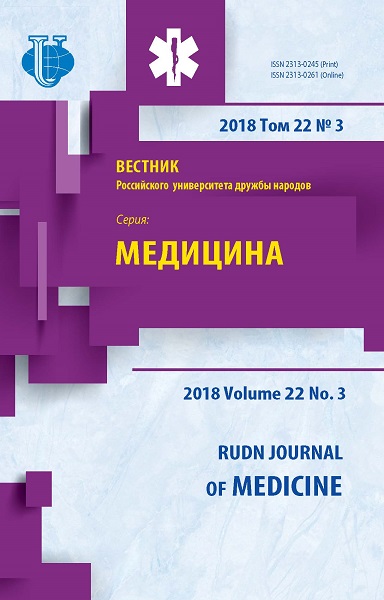EPIDEMIOLOGY OF AGE-RELATED ANDROGEN DEFICIENCY IN PATIENTS WITH BENIGN PROSTATIC HYPERPLASIA
- Authors: Chumakov PI1, Marchenko LA1, Kravchenko IV1
-
Affiliations:
- Stavropol’ State Medical University
- Issue: Vol 22, No 3 (2018)
- Pages: 272-278
- Section: SURGERY. ANDROLOGY
- URL: https://journals.rudn.ru/medicine/article/view/19672
- DOI: https://doi.org/10.22363/2313-0245-2018-22-3-272-278
Cite item
Full Text
Abstract
Every fourth patient at the age of 50 years, every third patient at the age of 60 years, every second man at the age of 70 years and almost everyone (90%) older than 80 years have Benign prostatic hyperplasia (BPH). Lower urinary tract symptoms developing against the background of BPH are often connected both with manifestations of the hyperplasia of a prostate, and with the age androgenic deficiency (AAD). Aim: To determine the frequency of emergence of age androgenic deficiency of patients with Benign prostatic hyperplasia (BPH). Materials and Methods: 180 patients with clinical signs of Benign prostatic hyperplasia have been examined. All patients were conducted with standard clinical examination: survey, measurement of International prostate symptom score (IPSS), assessment of quality of life (QOL). The research of the androgenic status of patients included clinical assessment of deficiency of androgens with the use of the standard international questionnaire: “The questionnaire of Aging Males’ Symptoms” (AMS) and hormonal blood test with determination of level of the general testosterone, follicle-stimulating and luteinizing hormones. Results: There were 118 patients with the low level of the general testosterone (Tgen) (67,7%) of all people. An average level of Tgen was 8,74 ± 0,9 nmol/l. In group of patients with low testosterone the GPA (grade point average) on a scale of AMS was 47,3 ± 9,1. Patients with BPH and AAD frequently have the accompanying pathology which is generally presented in such diseases as arterial hypertension, a metabolic syndrome, coronary heart disease, diabetes of the II type, anurolithic disease. Conclusions: Monitoring of the Tgen level is necessary for patients with BPH. Considering the high risk of a combination of BPH with the deficiency of testosterone it is necessary to include in the standard scheme of inspection the hormonal blood test with determination of the Tgen level.
About the authors
P I Chumakov
Stavropol’ State Medical University
Author for correspondence.
Email: p-chumakov@mail.ru
L A Marchenko
Stavropol’ State Medical University
Email: p-chumakov@mail.ru
I V Kravchenko
Stavropol’ State Medical University
Email: p-chumakov@mail.ru
References
- Gratzke C., Bachmann A., Descazeaud A., Drake M.J., Madersbacher S., Mamoulakis C. EAU Guidelines on the Assessment of Non-neurogenic Male Lower Urinary Tract Symptoms including Benign Prostatic Obstruction. Eur Urol. 2015;67:1099-109.
- Wang X., Lin W.J., Izumi K. Increased infiltrated macrophages in benign prostatic hyperplasia (BPH): role of stromal androgen receptor in macrophage-induced prostate stromal cell proliferation. J Biol Chem. 2012;287:18376.
- Kaprin A.D., Kostin A.A., Kulchenko N.G. The relationship of ultrasonic and morphological changes of the prostate tissue in patients with benign prostatic hyperplasia on a background of conservative therapy. Andrologiya i genitalnaya hirurgiya. 2012;3:47-51. (In Russian).
- Vuichoud C., Loughlin K.R. Benign prostatic hyperplasia: epidemiology, economics and evaluation. Can J Urol. 2015;22(1):1-6.
- Gandhi J., Weissbart S.J., Smith N.L., Kaplan S.A., Dagur G., Zumbo A., Joshi G., Khan S.A. The impact and management of sexual dysfunction secondary to pharmacological therapy of benign prostatic hyperplasia. Transl. Androl Urol. 2017;6:295-304.
- Kaprin A.D., Kostin A.A., Kulchenko N.G. Optimization of drug therapy for benign hyperplasia. Voprosy urologii i andrologii. 2013;1(2):5-9. (In Russian).
- Patel N.D., Parsons J.K. Epidemiology and etiology of benign prostatic hyperplasia and bladder outlet obstruction. Indian J Urol. 2014;30:170-176.
- Kulchenko N.G., Bicherova K.I., Strachuk A.G., Gudkova I.E. Clinical and morphological characteristics of the pancreas on the background of treatment with an inhibitor of 5-alphareductase for BPH. Zemskij vrach. 2012;5:55-56. (In Russian).
- Bostancia Y., Kazzazia A., Momtahenb S., Lazea J., Djavana B. Correlation between benign prostatic hyperplasia and inflammation. Curr. Opin Urol. 2013;23:5-10.
- Egan K.B. The epidemiology of benign prostatic hyperplasia associated with lower urinary tract symptoms: prevalence and incident rates. Urol Clin North Am. 2016; 43:289-97.
- ZHukov O.B., Zubarev A.R., Kul'chenko N.G. Vliyanie androgenozamestitel'noj terapii na gemodinamicheskie parametry vnutri organnogo krovotoka organov-mishenej testosterona. Andrologiya i genital'naya hirurgiya. 2008; 1:31-35. (In Russian).
- Eom C.S., Park J.H., Cho B.L., Choi H.C., Oh M.J., Kwon H.T. Metabolic syndrome and accompanying hyperinsulinemia have favorable effects on lower urinary tract symptoms in a generally healthy screened population. J Urol. 2011;186:175-179.
- Efremov E.A., Shekhovtsov S.Yu., Merinov D.S., Butov A.O., Kastrikin Yu.V., Garaev T.I. Change in testosterone levels in endoscopic operations on the prostate gland. Research’n Practical Medicine Journal (Issled. prakt. med.). 2018; 5(2): 48-55. (In Russian).
- Kasyan G.R., Konovalov I.V. Sovremennye vozmozhnosti kombinirovannoj terapii simptomov nizhnih mochevyvodyashchih putej na fone dobrokachestvennoj giperplazii predstatel’noj zhelezy u muzhchin. Issledovaniya i praktika v medicine. 2016; 3(2): 37-44. (In Russian).
- Nicholson T.M., Ricke W.A. Androgens and estrogens in benign prostatic hyperplasia: past, present and future. Differentiation. 2011;82:184.
- Kulchenko N.G. Optimizaciya podhodov konservativnoj terapii dobrokachestvennoj giperplazii predstatelnoj zhelezy inibitorami 5-al'fareduktazy. Kliniko-morfologicheskoe issledovanie. Kurskij nauchno-prakticheskij vestnik CHelovek i ego zdorov'e. 2012;1:101-106. (In Russian).
- Hirshburg J.M., Kelsey P.A., Therrien C.A., Gavino A.C., Reichenberg J.S. Adverse effects and safety of 5-alpha reductase inhibitors (finasteride, dutasteride): a systematic review. J Clin Aesthet Dermatol. 2016; 9: 56-62.
- Ngai H.Y., Yuen K.S., Ng C.M., Cheng C.H., Chu S.P. Metabolic syndrome and benign prostatic hyperplasia: An update. Asian J Urol. 2017; 4(3):164-173.
- Jarvis T.R., Chughtai B., Kaplan S.A. Testosterone and benign prostatic hyperplasia. Asian J Androl. 2015; 17:212-216.
- Giorgio I.R., Cimino S., Morgia G. Benign prostatic hyperplasia and metabolic syndrome: the expanding evidences of a new disease of aging male. Aging Male. 2015;18:133-134.
- World Medical Association. Declaration of Helsinki, Ethical Principles for Medical Research Involving Human Subjects. JAMA. 2013; 310 (20): 2191-2194.
- Gromov A.I., Builov V.M. Luchevaya diagnostika i terapiya v urologii [Radiation diagnostics and therapy in urology]. Мoscow: “GEOTAR-Media” Publ., 2011, 544 p. (In Russian).
- Bolockov A.S., Volkov A.A., Petrichko M.I. Ehlastografiya sdvigovoj volny v diagnostike zabolevanij predstatel'noj zhelezy. Medical news of the North Caucasus. 2013;8(3):73-75. (In Russian).
















